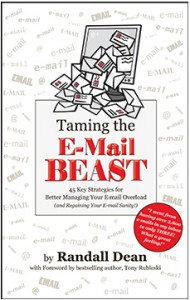

A Daily “Start-Up” Routine to Guarantee Project Priorities Trump E-mail Urgency
I’m frequently approached by project and people managers in my speaking and training programs on e-mail and Outlook management on how to reconcile the massive flow of e-mail many people are receiving with their need/desire to get more project-based work done and meet critical deadlines. Whenever this discussion comes up, I always like to ask where they put their focus first thing in the morning? Do they review their project plans/task list/calendar first, or do they open and check their e-mail first? If you are checking your e-mail first, you may be falling prey to “crisis du jour” planning, which can significantly impact your ability to meet your long-frame project goals/deadlines.
I’ve been recommending to key project management clients that they follow a fairly specific regimen at the start of the day that helps keep them from falling prey to “urgency planning”. This regimen will get your personal focus on your bigger project priorities first every day, allowing you to then integrate your e-mail-based tasks rather than inappropriately prioritizing those e-mail tasks to the detriment of your project plans/milestones. Here is that more prioritized start-of-the-day regimen:
- First, check your calendar, not just for today, but for the next 1-2 weeks. Your primary goal is to get a good feel for how many time commitments you are facing not only today but also in the next several days. You also want to simultaneously know how much “open block” time – time for project-based management and accomplishment, is available today specifically. This is a critical frame of mind starting every day, as you have multiple priorities, tasks, people, and plans to manage, and you have to figure out how to make them all fit in a limited amount of time.
- Next, refer to your primary project plan(s) – if you are actively managing a project(s), now, refer to those project plans, and pull individual action items from those plans – not only those that you need to accomplish personally, but also the follow-up and follow-through activities you need to take with others to keep your project assets (staff, contractors, vendors) on task and schedule. Put those active task items for today on today’s individual task list, be that on paper, in MS Outlook or MS Project, or any other planning software tool.
- Check your task list for sanity. Now, you know how much “open block” time you have for project-based accomplishment today and the next several days, as well as the key items on your task list from your key projects. Does your available time match your task list, or is your task list looking like something for an 18-hour day? This is the time to re-prioritize your task list for sanity – are there any low-level/priority tasks that can simply be moved to a later date? I call this “effective procrastination” – identifying tasks every day that are not mission critical, and, if you are overloaded, you can move to a later-yet-still-actionable date. By doing this, you are actually reducing “stress” in your personal system, by getting your daily task list to a realistic, actionable level. Also, by using effective procrastination, you are actually increasing the available time for accomplishing truly high-priority activities. This is also the time to call on additional resources if you realize that your project-critical tasks for this day (and coming days) go beyond your personal ability to manage/accomplish. Do you need to outsource tasks internally or externally to keep everything on plan?
- NOW, check your e-mail (voice mail, text messages, etc.) – Note that I strongly prefer you not even check your e-mail until you’ve checked calendar, checked your project plans, and refined/revised your daily task list. This forces you to get your longer-frame, big-picture priorities straight before checking your e-mail and letting the “crisis of the day” change your focus to the very short-term activities and tasks. Of course, your e-mail and other forms of current information (voice mail, faxes, text messages, etc.) are going to contain messages with updates, tasks, and information that will impact the prioritized action plan you have built for the day, and you do need to acknowledge them, but not to the detriment of your long-frame plans and activities. This leads to step 5:
- Recalibrate Task List one last time before starting to take action. Some of these new pieces of information will contain updates that will directly affect your project plans, critical path, and resource needs. Make the adjustments in your prioritized project/task plan and required follow-ups/ follow-throughs on your delegated tasks & deliverables, to adjust your daily plan to accommodate real urgency and changes. And then sanity check this adjusted task list one last time to make sure it is a realistic list for your available “open block” time per steps 1-3.
- Take action. Now, after going through steps 1-5, assuming you are not in a meeting, it is time to start knocking down that task list. I’d recommend following through with your delegated resources first before taking any individual actions of your own (an early reminder effectively gives that resource a whole additional day to accomplish the task). Once your delegation reminders are completed, your goal is to now knock out your personal prioritized task list for the day, and keep your project-based work moving appropriately, balancing true urgency with prioritized, proactive project management.
Obviously, this may require for you to get in the office to have time for this daily “morning routine” before the phone, e-mail, and fax machine start going crazy, and/or you head into “meeting insanity”! I always try to get into the office about 30-45 minutes prior to the majority of staff in my office so I can get this critical daily planning routine completed before everyone starts taking action and changing my plans. (Yes, being a morning person is greatly helpful as a project manager!)
And throughout the day, I’d recommend checking this daily task list both before and after checking your e-mail each and every time you do check e-mail. This will keep the focus of your project management consistently at the big-picture, proactive level it needs to be to meet the long-frame requirements of effective project management, while also accommodating the to-be-expected daily urgency. And it will keep your e-mail and other sources of “information overload” in the proper frame of true importance, so that you are managing it, rather than it managing you.
In my next entry, I’ll explain to you my recommended strategies for managing your e-mail each and every time you check your e-mail, allowing you to keep up with “quick items”, as well as properly dealing with both urgent and important items in those e-mails.
